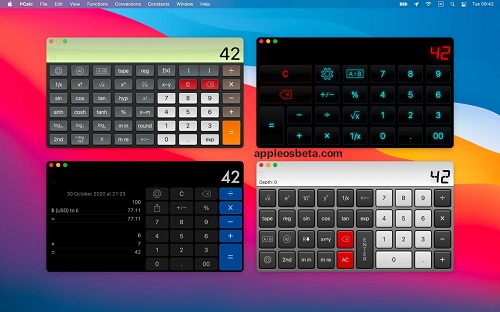30 years of PCalc, the alternative calculator for Mac. The developer of PCalc, historic utility for Mac, celebrates 30 years of his creature, software presented for the first time on December 23, 1992 and since then always updated and now available in macOS version , iPhone, iPad, tvOS and watchOS.
More than half of the 5G smartphones sold worldwide are iPhones
This “glorious” utility is a complete scientific calculator with support for hexadecimal, binary, octal calculations and support for the reverse Polish notation (RPN) syntax for mathematical formulas known to fans of the glorious HPs. There is obviously no shortage of trigonometric functions, those of conversion with the memorization (also customizable) of the main constants and everything that is possible to imagine for apps of this type.
The version for Apple Watch is very comfortable and allows you to transform Apple Watch into a calculator-watch similar to the Casio models and other manufacturers in vogue especially in the 80s. By downloading the version of PCalc for iPhone and iPad you also get the app for Apple Watch which allows you to make calculations on the fly directly from your wrist without having to remove your iPhone.
In addition to the complete functions of a standard basic calculator, the developer has seen fit to also include functions that allow you to quickly calculate the tip and split the bill among the diners. The tip function is essential in the USA where table service is often never included in the bill, in any case the same screen is useful anywhere in the world to quickly split the restaurant or bar bill with people who have eaten food and drinks in our company.
The developer reports that the app was born in 1992 when he was a student at the Computing Science department of the University of Glasgow. James Thomson was taking a human machine interaction course (teaching how to build proper interfaces) and one of the projects was to simulate a control panel for a central heating system, an idea he accomplished using the glorious Hypercard. At the time, the developer began to take an interest in coding with Think Pascal and the Macintosh API, and one of the first ideas after the success of the control panel for heating came to create a calculator. The calculator stock with Macs of the time was very simple, and the developer decided to create a more advanced application. The name PCalc is linked to features dedicated to programmers (Programmer’s Calculator). The utility was supposed to remain a simple project to use at home but the developer began distributing it to some friends and then on FTP archives that housed software of various types, downloadable by anyone in the world; and I begin to receive a lot of positive feedback and slowly l utility spread like wildfire.
In 2000 the application was compiled with Metrowerks CodeWarrior, then the “core” in Pascal was converted to C and the interface to C++. Later came the conversion for PowerPC systems and then on OS X, obviously adapting the interface.
At WWDC 2001 the developer gave his business card to a young Phil Schiller, to whom – during the event – he had spoken about PCalc; the latter wrote to get a serial number and it seems that Steve Jobs also used the utility. Apple co-founder Steve Wozniak bought several copies that same year.
In 2002 Apple gave the developer a big hand, distributing the standard app with the legendary iMac G4 (at the time the Calculator app was not standard on OS X). James Thomson and Apple struck a deal for very low costs to distribute the app but, the developer jokes, low prices multiplied by millions still give good results. Later, with the arrival of Mac OS 10.2 (Jaguar), Apple developed its own app and PCalc was no longer distributed with Macs. The author never abandoned the project and still continues to work regularly on this little but highly appreciated utility, adapting the code to the various versions of macOS.

